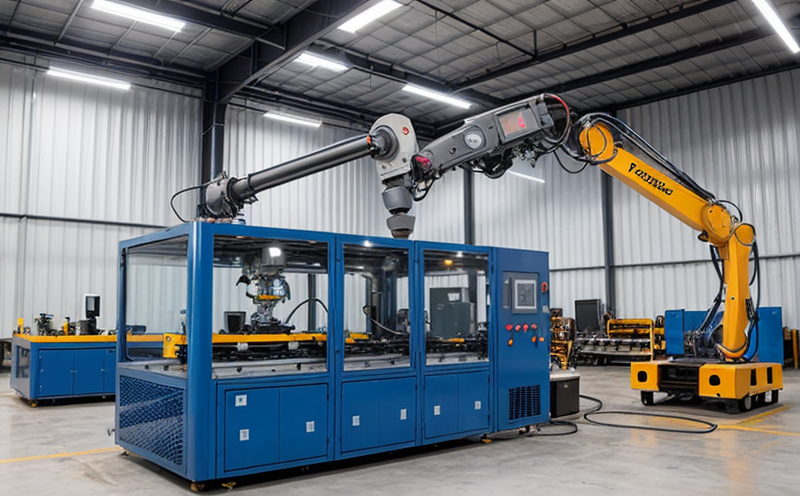ISO 18652 Load Capacity Testing of Robot Manipulators
The ISO 18652 standard provides a framework for testing the load capacity of robot manipulators, ensuring they meet safety and performance criteria. This test is critical in industrial manufacturing and processing to guarantee that robotic systems can handle specified payloads without compromising precision or stability.
Load testing of robot manipulators involves subjecting the system to various weights and forces to assess its structural integrity and operational limits. The standard specifies detailed procedures for preparing specimens, setting up the test environment, applying loads, monitoring performance, and recording results. Compliance with ISO 18652 is essential in industries where robotic automation plays a pivotal role.
For industrial manufacturing applications, ISO 18652 ensures that robotic arms are capable of handling materials without deformation or failure. This standard supports the development of safer and more efficient automated systems by providing a clear methodology for testing load capacity under controlled conditions. The test setup typically includes calibrated weights, strain gauges, and video cameras to capture data accurately.
The process begins with thorough preparation of the robot manipulator, including cleaning and lubricating joints as required. Specimen preparation involves attaching the robotic arm to a stable platform and securing it in place. Calibration of testing equipment is crucial to ensure accurate measurement of applied loads. Once everything is set up correctly, the test can commence by gradually increasing the load on the manipulator until specified criteria are met or exceeded.
During the test, critical parameters such as force distribution, joint angles, and movement coordinates are continuously monitored using advanced instrumentation. This information helps verify that the robotic arm operates within safe limits while maintaining precision during high-load conditions. After reaching peak loads, the system is inspected for any signs of wear or damage.
The final step in ISO 18652 load capacity testing involves recording comprehensive results and generating detailed reports. These documents provide insights into how well the robotic arm performed under various loading scenarios, helping manufacturers identify areas for improvement and ensuring compliance with relevant standards like ISO 9001:2015.
By adhering to this rigorous protocol, companies can build confidence in their automated systems' ability to perform tasks reliably and safely. This approach also supports continuous improvement efforts aimed at enhancing robot manipulator design and functionality across different sectors of industrial manufacturing.
| Test Parameter | Description |
|---|---|
| Load Applied | The weight or force applied to the robotic arm during testing. |
| Joint Angles | The angles between adjacent segments of the robot manipulator as it moves. |
| Movement Coordinates | The precise positions and orientations of the end effector relative to its starting point. |
| Force Distribution | How forces are distributed across various components of the robotic arm during operation. |
- Calibration of all testing equipment is necessary before beginning any load capacity tests.
- Adequate safety measures must be implemented to prevent accidents during the test process.
Industry Applications
ISO 18652 load capacity testing finds extensive use in several key industries:
- Automotive manufacturing, where robots are used for welding and painting tasks.
- Electronics assembly, involving precise placement of components on circuit boards.
- Packaging, ensuring packages are securely sealed without damaging the contents.
- Material handling, facilitating efficient movement of heavy goods within warehouses.
In these sectors, accurate load testing ensures that robotic systems operate safely and effectively even when handling large or delicate materials.
| Sector | Description |
|---|---|
| Automotive Manufacturing | Robots perform welding and painting tasks with precision. |
| Electronics Assembly | Precise placement of components on circuit boards is crucial. |
| Packaging | Ensuring packages are securely sealed without damaging the contents. |
| Material Handling | Efficient movement of heavy goods within warehouses enhances workflow. |
- Automotive: Ensures robots can handle large parts like engines safely.
- Electronics: Verifies accuracy in placing tiny components.
- Packaging: Prevents damage to fragile products during sealing processes.
- Material Handling: Supports smooth operations in storage facilities.
International Acceptance and Recognition
The ISO 18652 standard enjoys widespread acceptance globally due to its universal applicability and stringent quality assurance measures. Many countries have adopted this as a national benchmark for robotic arm load testing:
- Australia: Recognized under AS/NZS standards.
- New Zealand: Included in NZS specifications.
- United States: Part of ANSI/RIA R15 family guidelines.
- European Union: Endorsed by EN ISO 18652.
This standard is also widely respected internationally, contributing to the harmonization of robotic technology across borders. Compliance with ISO 18652 not only meets regulatory requirements but also fosters global interoperability among robotic systems.
Use Cases and Application Examples
Here are examples of real-world applications where ISO 18652 load capacity testing is applied:
- Automotive Assembly Line: Ensuring robots can safely lift and place vehicle components.
- Electronics Manufacturing: Testing the ability to handle delicate circuit boards without causing damage.
- Packaging Industry: Verifying that sealing machines operate correctly under specified loads.
- Material Handling Systems: Guaranteeing warehouse robots can transport heavy materials efficiently and safely.
In these scenarios, adherence to ISO 18652 ensures consistent performance and reliability of robotic systems across diverse industrial settings.





